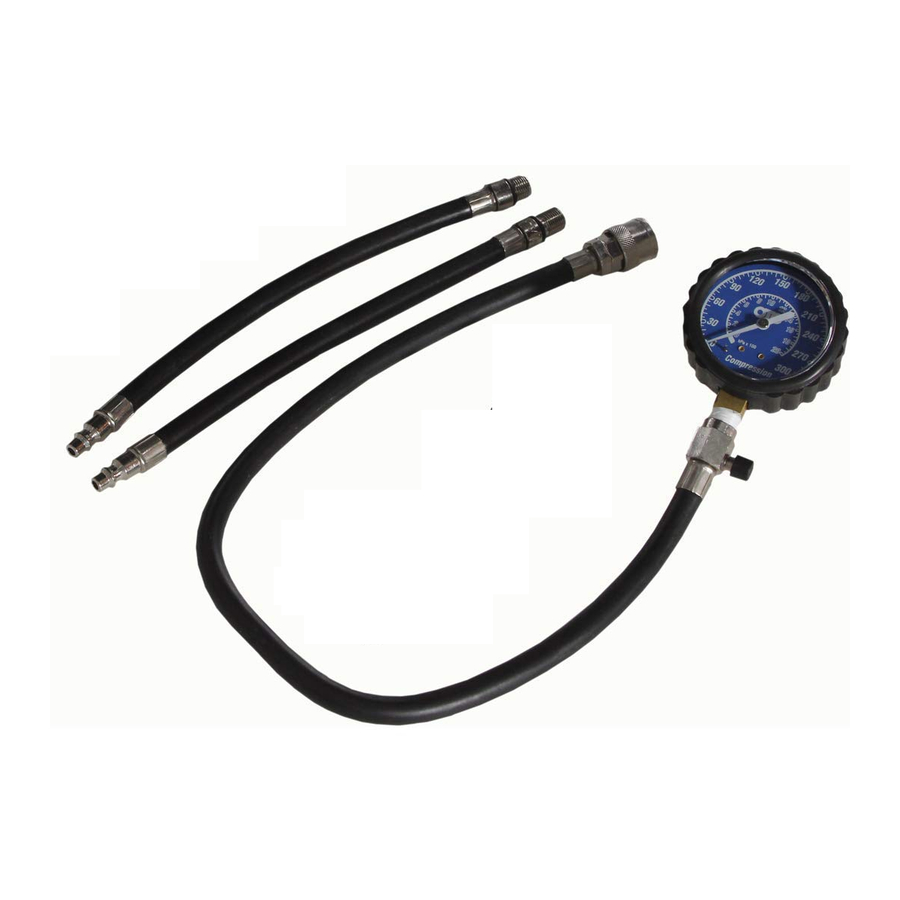Advertisement
Table of Contents
OTC 5606 Manual

Test Procedure
- Run the engine until it reaches normal operating temperature before performing the compression test.
- Stop the engine. Disconnect all the spark plug wires and number them according to the cylinder they were connected to.
- Loosen all spark plugs about one turn, but do not remove them. Use an air hose or stiff brush to remove all the dirt from the spark plug wells. Remove the spark plugs and place them on a clean, flat surface in the order according to the cylinder they were removed from.
- Remove the air filter and set the throttle plates to the wide open throttle position, being careful not to damage the linkage or throttle components.
Failure to return throttle plates to closed position before starting engine can cause serious engine damage. - Disable the ignition system. Follow the manufacturer's recommendations, or refer to a service manual for the proper procedure.
- Select the spark plug adapter and/or hose required for the vehicle. Screw the adapter and/or hose into a spark plug well. Hand tighten only - DO NOT USE A WRENCH.
![]()
NOTE: On engines with long reach plugs, use the long reach hose. Do not use the long reach hose in short reach holes – it may hit the top of the piston and damage the engine. - Connect the coupling on the gauge hose to the fitting on the spark plug hose. Be sure the hose couplings are fully engaged.
- Crank the engine for at least five compression strokes or until the pressure reading stops rising on the gauge.
- Record the compression reading, then push the side release valve to relieve the pressure as shown in Figure 2. Repeat the test. Record the reading, relieve the pressure, and remove the hose from the spark plug well.
![]()
- Reconnect the hose to the next spark plug well to be tested and repeat steps 6 through 10 for the remainder of the cylinders to be tested.
Test Results
- On a normal cylinder, the gauge needle should travel up-scale on each compression stroke until it reaches a peak value. All cylinders should indicate a pressure that is within the vehicle manufacturer's specifications, and the reading should not vary more than 10% from cylinder to cylinder.
- If the needle fails to travel up-scale as described in paragraph 1 above, or if it remains at the same value for several strokes and then starts to climb, the cylinder may have a sticking valve.
- If the compression reading is considerably higher than the vehicle manufacturer's specification, it may indicate carbon build-up in the cylinder. It may also indicate that the piston or cylinder head has been modified.
- If a reading on two adjacent cylinders is 20 psi (or more) lower than the other cylinders, a defective head gasket or cracked cylinder head may be indicated. Water (coolant) and oil may be found in the two cylinders under these conditions.
- If the readings are low or vary widely between cylinders, pour a teaspoon of grade 30 oil into each cylinder and retest. If the readings increase considerably, the fault may be due to poorly seated or worn piston rings. If the readings remain about the same, the valves and/or associated components may be the cause. A burned or damaged piston may also cause these results.
- Clean, regap, and reinstall the spark plugs in the same order in which they were removed, or install new spark plugs. Reconnect each spark plug wire to the spark plug it was connected to. Return the throttle plates to closed throttle position. Reconnect the ignition system wiring, which was disconnected in Step 5 of this Test Procedure.
Repair Parts List
| Part Number | Description |
| 0031-0460 | Compression Gauge |
| 0400-3009 | Gauge Boot |
| 0032-0137 | 26" Hose and Release Valve |
| 0180-0893 | 10mm Adapter |
| 0180-1495 | 12mm Adapter |
| 0180-1496 | 18mm Adapter |
| 0032-0135 | 14mm Standard Hose Assembly |
| 0032-0136 | 14mm Long Reach Hose Assembly |
| 1000-5143 | Repair Kit |
| 0400-3109 | Carry Case |
| 0001-3894 | Instruction Label |
1-800-533-6127
Documents / ResourcesDownload manual
Here you can download full pdf version of manual, it may contain additional safety instructions, warranty information, FCC rules, etc.
Advertisement







Need help?
Do you have a question about the 5606 and is the answer not in the manual?
Questions and answers